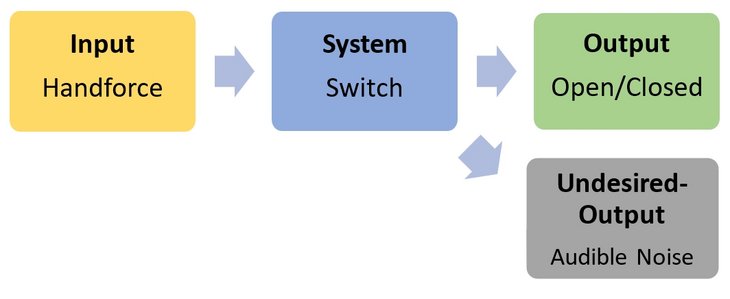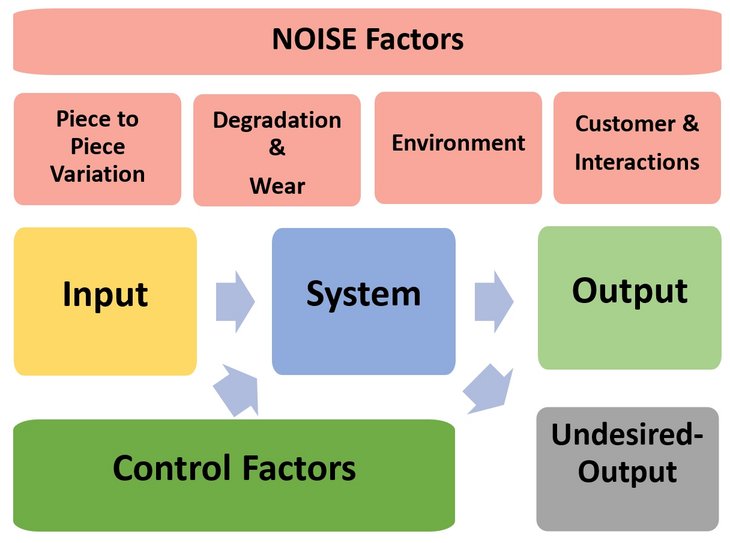The P-Diagram is frequently used when asking questions about supporting tools during the use of quality tools. In addition to the confusion about the abbreviation "P", it is often named the extended influence and effect diagram, but is this correct? How can the P-Diagram help me with and what is the meaning of P-diagram?
This short overview demonstrates the use of the P Diagram, its benefits and suitable applications.
The P-Diagram is a useful tool for determining, documenting and visualizing factors (parameters) influencing a system, a system function or a production process. The visual representation is based on the central position of the system/function/process.
Every system, function and process have the input factors, named the inputs. The central element converts the inputs into output results, the outputs. Imagine a rocker switch. The rocker switch has the task of closing or opening an electrical contact from a mechanical movement, the actuation of the rocker. The mechanical force flips the rocker, the switch opens or closes an electrical contact.
 In addition to the desired output, undesirable side effects usually occur. These are referred to in the P diagram as "Undesired output, side effects, undesired output". When developing and searching for these undesired side-effects, it is important to ensure that they are not the negations of the outputs.
In addition to the desired output, undesirable side effects usually occur. These are referred to in the P diagram as "Undesired output, side effects, undesired output". When developing and searching for these undesired side-effects, it is important to ensure that they are not the negations of the outputs.
 In the following step two further important influencing factors are determined and documented.
In the following step two further important influencing factors are determined and documented.
Noise factors and control factors provide the probably most essential information about the selectable control factors and the noise factors which have to be considered.
Let us start with the noise factors. These factors are based on systematic variance. The term "noise factor" is based on the fact that these factors have an influence on the ideal system function, but as already mentioned, cannot be isolated from the system (process), or only with very high efforts. These environmental influences will affect our switch, such as: water, dust, vibrations, which cannot be easily separated from the system. In addition, there are customer influences, variations in manual force, frequent use, and expected misuse, such as hitting the rocker. As an important, and therefore unavoidable, influence, we have to include process deviations, part to part deviation, manufacturing variations, environmental influences, material variation, system interactions, customer influences, etc.
The control factors stand against these non-adjustable influencing parameters (noises). These are parameters to be selected, with the help of which the system / system function is made robust against the noise factors, such as the choice of material, surface coating, etc.
This results in the following P-diagram:
 If we take a closer look at the customer influences in this example, the following noise factors result for our switch: Variation of manual force, hitting, cleaning, frequent use, pressing on the axis of symmetry, which is likely to have an influence on the function and durability of the system. Now it is the task to identify "against" the disturbance variables control variables (design or process) to make the system switch "robust" against those noises.
If we take a closer look at the customer influences in this example, the following noise factors result for our switch: Variation of manual force, hitting, cleaning, frequent use, pressing on the axis of symmetry, which is likely to have an influence on the function and durability of the system. Now it is the task to identify "against" the disturbance variables control variables (design or process) to make the system switch "robust" against those noises.
This form of factor analysis (noises and control variables) provides me with a wide range of information about my system and the system functions.
The information obtained in this way can be incorporated into the FMEA. I receive: System functions, unwanted system functions, possible causes of errors and defects. I am able to develop control methods and Effects for the FMEA development.
In summitry, the P-Diagram is a powerful tool which can be very helpful in the development of an FMEA. The application and use of this clear and compact tool is an success factor in FMEA moderation and development, and a safe way to bring a breath of fresh air with lots of information into the often occuring lack of ideas and monotony in the development of FMEA inputs.
Author:![Ralf Kleideiter [FMEAplus Academy] Ralf Kleideiter [FMEAplus Academy]](/fileadmin/user_upload/News/2021/Ralf-Kleideiter.jpg)
Ralf Kleideiter
Trainer FMEAplus Academy
[This article was first published in FMEAplus Magazin]




